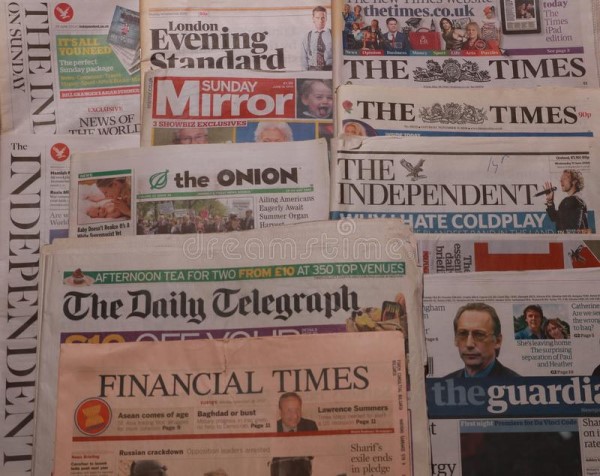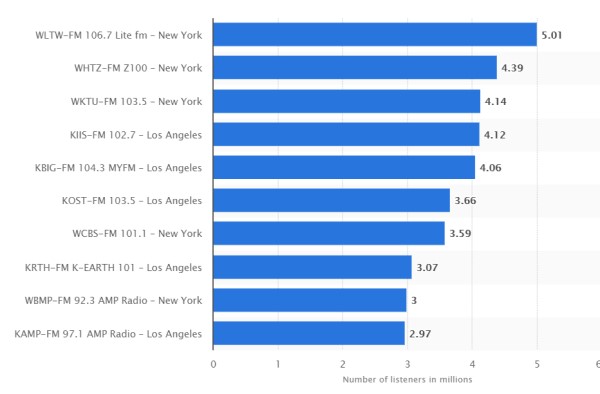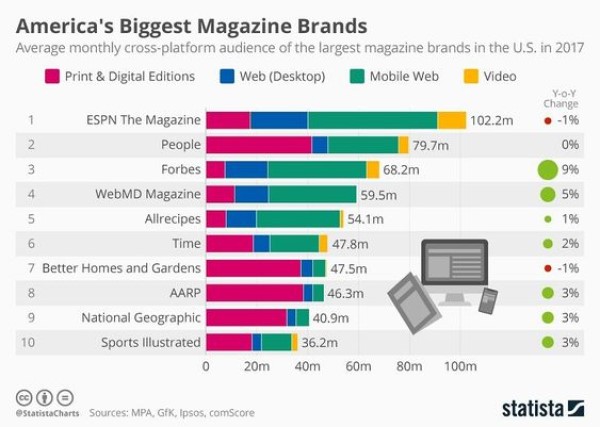Mass media
What I already know about this topic
Create a mind map to the given expression. Collect your ideas.
United Kingdom
Just like in other developed countries, mass media in the United Kingdom has several different types: newspapers and magazines, books, television, radio, and the Internet. The center of the British media industry is London, with most national newspapers, television and radio broadcastersműsorszolgáltatók, and publisherskiadók residing there. Apart from London, Greater Manchester is also an important national media center in England, while Edinburgh, Glasgow, and Cardiff serve as the most important hubscsomópontok of newspaper publicationkiadás and broadcasting in Scotland and Wales.
One of the most important providers of mass media in the UK is the British Broadcasting Corporation (BBC), a state-owned, independent public service broadcaster with 24,000 employees. BBC broadcasts a huge variety of programs on several TV channels and a large number of national and local radio channels. Apart from BBC, another British public television broadcasting company is Channel 4, while there are two commercial televisionkereskedelmi tv companies, Channel 5 and ITV. These four companies provide the most important nationwide TV channels, including BBC One, BBC Two, ITV, Channel 4, and Channel 5. Apart from these providers, the UK’s digital terrestrialszárazföldi Freeview service runs a large variety of entertainmentszórakoztatás, music, and sports channels, while Virgin Media is a digital cable televisionkábeltévé service provider (with both terrestrial and satellite televisionműholdas tv. In the UK, there is no analogueanalóg television, as the whole country switched to digital TV in 2012.

Similarly to British television, radio in the UK is also dominated by the BBC. The BBC World Service radio network is broadcast in more than thirty languages all around the world. The most popular radio stations are BBC Radio 2 and BBC Radio 4. Many local radio stations in the UK are owned by large radio groups, such as Global Radio (which owns the radio brands of Heart, Smooth, Capital, Classic FM, LBC, and Radio X), Wireless Group, and Bauer Radio. Apart from these, there are community radio stations, which have local audiences.
In the UK, both television and radio service providers can operate with licenses. The Independent Television Commission (ITC) regulates and licenses commercial television service, while the Radio Authority regulates and licenses commercial radio service. The most prestigioustekintélyes television awards in the country are
- the British Academy Television Awards (BAFTA TV Awards), which have been presented annually in a ceremony hosted by BAFTA since 1955,
- and the National Television Awards (NTAs), the results of which are decided based on votes by the public.
British newspapers are traditionally divided into “quality” and “tabloidbulvárlap” papers. Quality papers (also called broadsheet papersnapilapok because of their traditional large format), including
- The Times,
- The Financial Times,
- The Guardian,
- The Observer, and
- The Daily Telegraph,
generally report national and international news stories and are focused on politics, business, arts, and sport. Broadsheet (and formally broadsheet) papers are often associated with political sides, such as the center-right Times and Daily Telegraph or the center-left Guardian or Observer. Tabloid papers, on the other hand, focus on sensationalfeltűnést keltő news, unusual events, catastrophes, the private lives of the Royal Family and the nobility, celebrities, artists, musicians, and movie stars.
- The Sun,
- Daily Mail,
- Daily Express,
- Daily Mirror,
- and Daily Star
belong to this newspaper category. Many of the daily newspapers have their Sunday counterparts, such as The Sunday Times, Sunday Express, and Sunday Mirror, which have more content than the daily papers, and many of them include color supplementsmellékletek with articles on culture, sport, and entertainment. Apart from the national papers, there are a large number of local newspapers dealing with local events and advertising local businesses. AdditionallyTovábbá, there are free newspapers (or freesheets) in urban centers, such as the Metro or Evening Standard, which have more advertising in their issueskiadványok. Newspapers in the UK are privately owned media products and have considerable freedom of expressionszólásszabadság.

Apart from newspapers, there are a wide range of magazines published in the UK, focusing on topics such as business and finance, science, art, literature, cinema, media, music, sport, health, fashion, and many more areas of interest. Among the most popular magazines by circulationpéldányszám, we can find The National Trust Magazine, TV Choice, What’s On TV, Radio Times, Slimming World, Good Housekeeping, Stylist, and Woman’s Weekly. Some of the most well-establishedelismert magazines in the UK include
- The Economist,
- The Spectator,
- New Statesman,
- Country Life,
- Vogue,
- Elle,
- Tatler,
- Cosmopolitan,
- Hello!,
- Private Eye,
- New Musical Express (NME),
- The Wire,
- Sight & Sound,
- Nature,
- and New Scientist.
Many of these magazines are published in several other countries outside the UK.
Apart from newspapers and magazines, books constitute a huge proportion of print medianyomtatott sajtó in the UK, as well. The biggest publishers of books in the country include Penguin Random House, HarperCollins, Macmillan, Bloomsbury, Pearson, Simon & Schuster, and the big university pressesegyetemi kiadók such as Oxford University Press and Cambridge University Press. Most of these publishers have multiple imprintscégjelzések, that is, trade names under which the publishers publish certain types of books which are marketed to different consumer segmentsfogyasztói szegmensek.
United States
As the United States is a huge country, most of its important newspapers are local, such as The Los Angeles Times, The Chicago Tribune, and The Washington Post, as well as Daily News and Post (both in New York City). USA Today, The Wall Street Journal, and the national edition of The New York Times are, however, nationwide newspapers. As in other countries, newspaper circulation numbers in the US have also been declining since the 1990s, and most newspapers have supplemented or exchanged their print publications with online versions. Although almost all papers have lost significant portionsrészek of their print circulation due to the rise of the Internet, the major ones (such as The New York Times, The Washington Post, and The Wall Street Journal) have had considerable circulation gainsprofit in digital subscriptionselőfizetések. These papers are well-known all over the world; for example, The Wall Street Journal has international editions in Japanese and Chinese, as well. There are also a large number of magazines published in the US, including such famous titles as
- National Geographic,
- WIRED,
- Newsweek,
- Time,
- US Weekly,
and many more. Just like in the UK, the various lifestyle and special interest magazines (such as People, Better Homes and Gardens, Game Informer, Good Housekeeping, and AARP The Magazine) have higher circulation than news and opinion magazines, although the latter are often more highly esteemednagyra becsült. With the adventmegjelenés of the Internet, advertising has also shifted to digital platforms, which resulted in the loss of advertising revenuehirdetési bevételek in newspapers and magazines. Consequently, the number of employees working in the print media sector has also decreased considerably in the past decades.
Radio is also popular in the US, with hundreds of commercial radio stations all around the country, many of which belong to chainssorozatok with hundreds of radio stations, such as iHeart Media, CBS, and Cumulus Media. The majority of radio programs in the US are music programs, although there are news programs and talk shows as well. While traditionally, party-press parallelismpárt-sajtó párhuzamosság was not a major characteristic feature of American media, it has increased lately, so now quite a lot of media outletssajtó-orgánumok (including radio and television channels) have strong affiliationskapcsolatok with political parties.

In the US, television is still a major medium and news sourcehírforrás: about half of the American people get the news from television. The national broadcast networks play a vital role in American television, with
- ABC,
- CBS,
- NBC,
- Fox,
- and Univisón
being the most important ones. Univisión is a national Spanish-language network, the largest of the ethnic media in the US (other ethnic media include regional Spanish-language radio stations, and African American magazines and TV channels). Local stations also play an important part in the American television system, as they constitute the largest source of news for Americans. Apart from national and local networks, cable television forms a vital part of the system, with Fox News, CNN, and MSNBC being the most important channels. The most prestigious awards appreciatingértékelő television programs in the US are the Emmy Awards, which are given annually in several categories at events such as Primetime Emmys, Daytime Emmys, Sports Emmys, and News and Documentary Emmys.
With the development of the Internet, streaming services"streaming" szolgáltatások (or over-the-top, OTT services) have become a key element on the media landscape both in the US and elsewhere. OTT services provide streamed content directly to the viewers, so there is no intermediary platformközvetítő platform controlled by a distributorviszonteladó. Streaming companies provide video-on-demand (SVoD) television and film services typically on a subscription basis, where part of the content is bought from other producers, and part of it is produced by the streaming companies themselves. OTT services are typically accessed via websites on personal computers (PCs), mobile devices, digital media players (such as game consoles), and smart television sets. Some of the most important OTT providers in the US include
- Netflix,
- HBO Max (HBO Go outside the US),
- Hulu,
- Disney+,
- YouTube (which has both free and premium services),
- and Amazon.
As television series have become a dominant form of visual entertainment, streaming services investberuház huge amounts of money into making highly popular television series to boostfellendít subscriptions. Some of the most popular recent streaming shows include BoJack Horseman (an animated series), Stranger Things, Ozark, The Crown, The Witcher, The Umbrella Academy, Mindhunter, The Queen’s Gambit, Dear White People, Orange Is the New Black, Jessica Jones, House of Cards, Daredevil, Bridgerton, Chernobyl, Watchmen, Sharp Objects, The Expanse, The Handmaid’s Tale, Mr. Robot, Justified, and many more.
Some of the largest book publishers in the US are basically the same as those in the UK. The “Big Five” trade publishers in the country are Penguin Random House, HarperCollins, Simon & Schuster, the Hachette Book Group, and Macmillan Publishers. The number of university presses (academic publishers focusing on the publishing of books on academic topics) in the US is impressivelenyűgöző but not surprising, given the number of universities and colleges in the country. Some of the top-rankedfelső kategóriás university presses in the US include Cambridge University Press, University of Chicago Press, Columbia University Press, Harvard University Press, and MIT Press.

Australia
Australia also has a diverse media industry, where traditional and digital media forms are equally present, including newspapers and magazines, radio, television, and the Internet. Media sources provide services on the local, regional, national, and international level. The most popular televisions networks in the country are
- Nine Network (commonly known as Channel Nine or simply Nine),
- Seven Network (that is, Channel Seven or Seven),
- Network 10 (Channel 10 or simply 10),
- ABC Television,
- and SBS,
while newspapers with the highest circulation include
- The Australian Financial Review,
- The Australian,
- The Canberra Times,
- Daily Telegraph,
- and The Sydney Morning Herald.
Other notable newspapers and news websites are news.com, ABC News Online, The Age, Seven News Online, SBS News Online, Herald Sun, Nine News, The Guardian Australia, The Saturday Paper, and The Spectator. The two major owners of newspapers in the country are News Corp Australia and Nine Entertainment.
The most important national news radio broadcasters are the Australian Broadcasting Corporation (ABC), which operates several national radio news networks (including ABC News Radio and ABC Radio National), more than fifty local news stations through ABC Local Radio, and several digital radio stations; and the Special Broadcasting Service (SBS), which also deliversszállít Australian-produced news content in languages other than English.

Canada
Just like the US, Canada also has diverse and regionalizedrégiókra osztott/régiók szerinti print and digital media, which is dominated by a few corporations, most notably, the Canadian Broadcasting Corporation (CBC). CBC, the national broadcaster of the country, has both English-language and French-language services (with the names CBC and Radio-Canada for the two different language services, respectively), while it is also a major content producertartalomgyártó. Film and television content in Canada is produced both domestically and imported mainly from the US, the UK, Australia, and France. Canadian films and television programs are becoming more and more popular worldwide, thanks to digital streaming platforms such as Netflix.
While most Canadian media services (television, magazines, and newspapers) are provided by for-profit organizations, the Canadian government supports the television and publishing sector to maintain their profitabilityjövedelmezőség by enforcingérvényesítés regulations that give the domestic companies a competitive advantageversenyelőny (such as tax laws limiting foreign advertising). Apart from the national services of CBC, some of the provincial governments also have their own public television broadcast services such as Télé-Québec or TVOntario. As for print publishing, the most popular English-language newspapers in Canada are The Globe and Mail, Toronto Star, Hamilton Spectator, Montreal Gazette, The Province, National Post, Vancouver Sun, Calgary Herald, Toronto Sun, and Windsor Star.
Printed media
Despite the huge number of newspapers and magazines published in the English-speaking countries, the popularity of printed media has been falling steadily with the advent of the Internet, as more and more readers seek news and information online. Because of this tendency, a lot of newspapers and magazines now have a marked online presence, either providing a free digital counterpartsmásolatok to their printed product or having a digital paywalled subscription schemefizetőfalas előfizetési rendszer. Some of the papers and magazines now have more readers online than offline, although – due to the “free nature” of the Internet – it is hard for the publishers to make online readership profitable. Some papers, such as The Guardian, have freely available online versions, while the paper tries to raise revenue from reader donations. Others, such as The Daily Telegraph, have subscription systems with monthly and/or annual fees and varying degrees of accesshozzáférési fokok (such as standard and premium or “all-access”). Newspapers and magazines also utilizehasznál digital media genres such as podcasts and video channels.
Digital platforms
In the UK and the US, as well as in other parts of the world, the digital platforms and intermediariesközvetítők (mostly US organizations) largely determine how people access information online. As the researchers of the study Who Owns the UK Media (2019) state, “these entitiesdolgok act as the gatekeeperskapusok determining how the public obtainsmegszerez information (through search); how people communicate (through social media) and how citizens access news and journalism.” The major digital platforms that serve as gatekeepers are Google for internet search, YouTube for video content, and Amazon for e-commerce. At the same time, social media is dominated by Facebook, with Instagram, Snapchat, and Twitter also having a large number of users.
Social media
As an increasing number of users access news via social media, the owners of these platforms now have a greater responsibility for transparentnyílt, világos and ethical communication. A case in pointkülönleges eset may be the online spreading of fake news and false information on a variety of topics, for example, the COVID-19 pandemic and vaccination. In early 2021, Facebook decided to censor false information and anti-vaccination sentimentsnézetek more strictly, trying to foster the global fight against the pandemic. Because the Internet is a decentralized and interactive medium, where the users themselves may produce almost any content they like, it is much harder to control content online than in print media or on radio and television channels. Traditional offline media platforms follow more established traditions and stricter standards of content production by employing professionals to produce and edit content. Thus, while online content is much more easily accessible and readily availablekönnyen elérhető, the regulation and “quality control” of published content is much harder to exercise. It is probably the reason why audiences still trust television, radio, and print publications more than online platforms, while they consume more online content.

Advertising
Advertising has long been one of the greatest controversiesviták of media, especially since the emergencekialakulás of commercial television, although advertisements appear in all other forms of mass media, including newspapers, magazines, radio, direct mail, and various online platforms such as search engineskeresőmotorok, blogs, social media, websites, and text messages (for example, in the form of e-mail spam). In England, the first newspaper advertisements appeared in the 18th century, but even in these early times, false ads and quacksszélhámosságok were already a problem. Advertisements started to spread with industrialization, especially in the 20th century. Radio advertisements appeared in the 1920s, while the first paid TV ad was broadcast in the US in 1941, and the UK in 1955. Private television networks and radio stations are primarily funded by their advertising revenue, and the number of radio advertisements and television commercials has grown in the past decades. With the predominanceuralkodás of the Internet in the 21st century, revenues from Internet advertising now tend to surpassfelülmúl those of television. With the rapid growth of online advertising, stricter regulations have become necessary in this segment, as well. Big data has also made it possible to personalizeszemélyessé tesz advertising more effectively, primarily based on the web browsing behaviorwebböngészési viselkedés of Internet users. This has also boosted interactive advertising, a type of advertising which encourages user participation by various means, such as augmentednövelt reality (AR), virtual reality (VR), quizzes, questions, or QR codes.